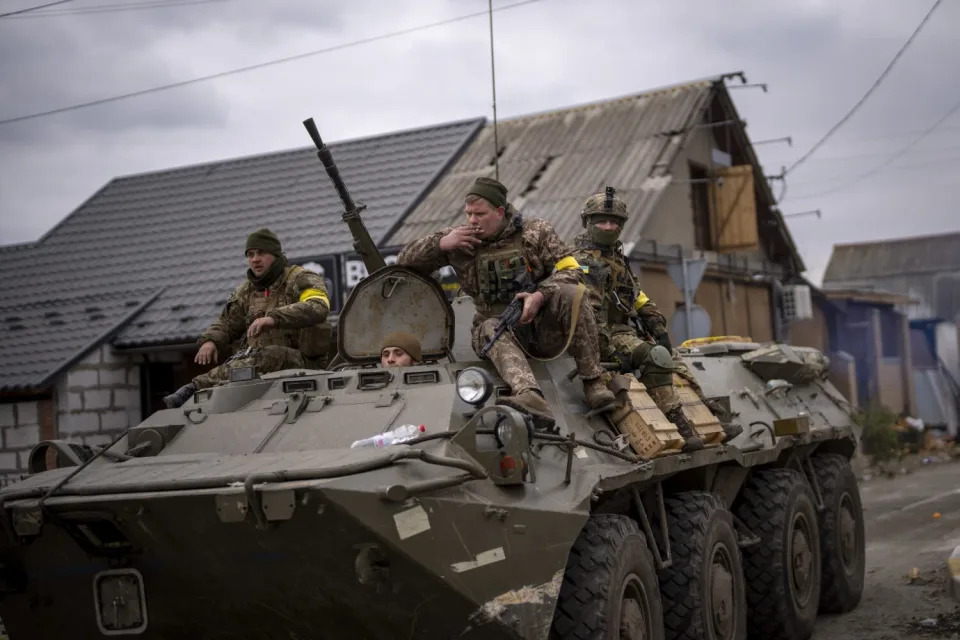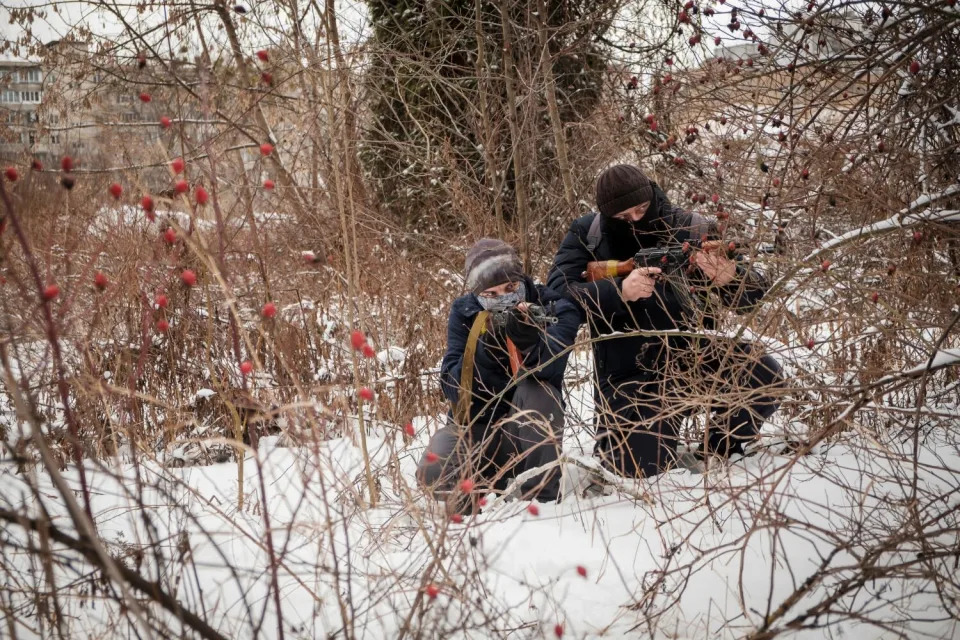Los Angeles Times
Ukraine’s army, vastly outgunned, inflicts losses on more powerful Russian forces
Nabih Bulos – March 9, 2022
The Russian soldier wrenched the steering wheel to the right, digging furrows in the embankment as the truck lurched onto a field astride the M06 highway near Kyiv. He barreled down a few dozen yards, desperate to escape the Ukrainian forces that ambushed his armored column a few miles away when he ran into another unit.
“We got the info that they were coming down this road; our intelligence groups told us,” said Vasil, a 57-year-old Ukrainian tank operator sitting at a picnic table in the bushes on the side of the highway. A few yards away was his tank; it too was obscured by the trees, like a bulky beast with its turret pointed toward the road.
“They were more than us. We used everything we had.”
The driver’s corpse and the burnt husk of the overturned Russian truck seemed proof that it was enough.

The recent skirmish was one of the many surprises of this invasion, now entering its third week: The Ukrainian army, outmanned and outgunned by several magnitudes, has somehow been able not just to survive, but to bog down and score palpable hits against its adversary, even as Russian forces have expanded their reach in the east and south.
Rather than a lightning-fast assault made up of tank columns and swarms of helicopters meant to overrun Kyiv in a few days, the Russian onslaught — the largest ground war in Europe since 1945 — has been marked more by what observers and Ukrainian soldiers see as a lack of coordination, with Russian armor often entering areas with little infantry support or protection from above.
“It’s f— up. They come with very big columns, 30, 40 in a line, and they just go at us. Yes, they use planes, artillery, but we’re smart and we know the terrain well; they’re panicked so we stop them,” said Vladimir Korotya, a deputy administrator in Bucha, a town northwest of Kyiv, who has since become a commander in the fight against Russian forces.
“Russian soldiers fight well, but their tactics are inexplicable.”
Vasil, asked about his unit’s clashes, criticized the Russians as “uncoordinated.”
“They’re in a land that is not theirs, and they don’t know what they’re doing,” he said.
Observers have chalked up Russia’s poor performance thus far — Kyiv still stands and the second largest city, Kharkiv, has yet to fall — to a lack of morale, faulty intelligence and what appear to be logistical issues that have occasionally bordered on the comedic. Videos on social media depict Russian troops surrendering because they got lost or having their vehicles towed by Ukrainian farmers atop tractors when they ran out of gas.
“The Russians have had huge logistics problems. They have expended most of their first and second lines of ammunition,” said Jack Watling, an expert with the Royal United Services Institute, in an interview with the BBC on Tuesday. “And therefore we actually saw a real lull in their operational tempo over the weekend while they tried to reset.”
That has also extended to air operations. With the Ukrainian air force still flying, not to mention Western nations delivering hundreds if not thousands of shoulder-fired antiaircraft missiles to Ukrainian troops, Russia has not been able to or has chosen not to fully deploy its air power.
On Wednesday, an intelligence update by the British Defense Ministry said Ukrainian air defenses appear to have “enjoyed considerable success against Russians’ modern combat aircraft.”
“Initially, they assumed that they would immediately establish air superiority. They didn’t, and so they were taking very considerable losses,” Watling said, adding that though the Russians have “a depth of aircraft, at the moment they are taking unsustainable losses.”
“The question is whether the Ukrainians can continue to inflict that rate of loss,” he said.

In Ukraine’s eastern and southern regions, Russian President Vladimir Putin’s forces have had more success. They have pushed into parts of the disputed Donbas region in eastern Ukraine; using a potent combination of land, sea and air units, they now besiege Mariupol and other cities on Ukraine’s Black Sea coast. But even there, the offensive has yet to reach the country’s largest and most significant port, Odesa.
That the force of numbers and destructive power of the Russian war machine can eventually overwhelm Ukrainian troops is not in doubt: Russia has more than four times the troops, more than six times the armored vehicles and tanks and almost 10 times the aircraft and helicopters. It may be part of Moscow’s strategy not to fully muster its arsenal or expend too much of its munitions in a conflict that could drag on and possibly draw in other nations. But some intelligence officials suggest Moscow will turn more aggressive.
“Our analysts assess that Putin is unlikely to be deterred by such setbacks and instead may escalate, essentially doubling down,” Director of National Intelligence Avril Haines told U.S. lawmakers Tuesday.
Experts also caution that the information coming from the battlefield isn’t giving a full picture.
“There’s a lot of noise in the information environment,” said Marta Kepe, a senior defense analyst at Rand Corp. She added that though there have already been examples of Russian forces bombing and shelling urban areas, ground combat between armies has been less common, and there’s little insight as to what the Ukrainian army is doing. American officials say 2,000 to 4,000 Russian troops have been killed since the invasion began on Feb. 24.
Part of the reason for that, said retired Maj. John Spencer, who chairs the Urban Warfare Studies department at the Madison Policy Forum, is that the Ukrainian army isn’t conducting large-scale military engagements.
“It would make no sense for the Ukrainian army to go military to military against the Russians. To be out in the open, especially if you’re not technologically more advanced, it’s suicide,” he said. Instead, Ukrainian forces have relied on a combination of guerrilla tactics.
“They know where to hide; they can establish ambushes, they can get out of dense urban terrain, pop out, fade back in,” he said.
But Russia has also yet to unleash the full power of its military might, especially when trying to dislodge Ukrainian forces from major cities. That was the strategy in Syria, when Russia, along with its Syrian government allies, carried out a devastating campaign to subdue rebels in the city of Aleppo. Spencer brought up the example of Chechnya, where Russian forces began their offensive with 3,000 artillery rounds a day before they ramped up to 30,000.

“That’s the level of bombing that a city like Kyiv should be prepared to take without giving up,” he said.
Even if Russia does manage to press its advantages and steamroll into Kyiv and install a pro-Moscow government, it seems certain that it will face a grinding insurgency, not just in the capital but across the country.
The seeds of that resistance can already be seen. Russian-occupied cities such as Kherson in the south have erupted in protests against Russian rule. In Novopskov, in the Donbas, demonstrations stopped only because Russian troops reportedly shot a number of protesters earlier this week.
Then there’s Ukrainian President Volodymyr Zelensky: His insistence on staying in the capital — going so far as to release videos showing him walking in his office in Kyiv — and delivering rousing speeches on social media have boosted fighting morale, something even his most vociferous critics acknowledge.

Even more crucially, the large number of cadres from the general population has allowed the army to outsource guarding territory — not to mention intelligence on enemy movements — to reservists. Western governments also have a pipeline for weapons ready to be reoriented toward an insurgency.
“The only reason the army has survived is because they went from whatever they were before the invasion to eventually millions — although untrained — civilians assisting in the military campaign,” Spencer said.
“That’s not really as normal as people would think it is. They’ve added to the combat power of the Ukrainian military.”
